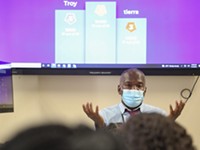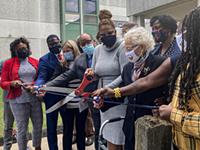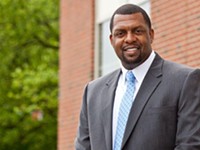[
{
"name": "500x250 Ad",
"insertPoint": "5",
"component": "15667920",
"parentWrapperClass": "",
"requiredCountToDisplay": "1"
}
]
When you hear stories about New York State's urban schools and budget problems, you might assume that only the "Big Five" urban districts (including Rochester) are in a bind. But a new report from the Campaign for Fiscal Equity says, basically, we're all in this together.
Well, most of us.
On March 30, the American Institutes of Research and Management Analysis & Planning Inc., under CFE's auspices, put out its New York Adequacy Study. AIR and MAP worked with dozens of teachers and academics, and also got help from groups like the New York State School Boards Association and the Albany-based Fiscal Policy Institute.
The study specifies how New York State should implement what's become known as the "CFE decision," a Court of Appeals judgment that required more spending for high-needs schools in New York City (and by extension, other high-poverty areas). The court set July 30 as the deadline for an implementation plan.
So how are most New York Staters in the same boat? The study charges that 517 school districts in New York State "will require increased investment" to ensure a "Regents-level education." A good number of Monroe County school districts are on the list: Brockport, Churchville-Chili, East Irondequoit, Gates-Chili, Greece, Hilton, Honeoye Falls-Lima, Rochester, Spencerport, West Irondequoit, and Wheatland-Chili. (The county's most affluent suburbs are conspicuously absent.)
There's a wide range of need here, of course. The study says the Rochester city schools need a boost in state funding of around 40 percent. East Irondequoit needs 17 percent more, says the study, while Hilton needs just 3 percent more.
Neighboring counties are represented, too. The study says Wayne County's Gananda and Red Creek districts need 43 percent and 34 percent more, respectively. Geneseo and Mt. Morris, both in Livingston County, need 15 percent and 38 percent more, respectively; and Wyoming County's Letchworth district needs a whopping 61 percent more, says the study.
All in all, the Adequacy Study says New York State must increase its school spending by $6.6 billion to more than $9 billion over four years.
But it's not just about dollars and cents. The study lays the program areas into which the money should flow.
The target areas include the key structures of progressive educational reform: significantly smaller class sizes, pre-K in all schools (including a half-day program for three-year-olds), more teaching assistants and specialists, and some extended-day and extended-year programs.
Governor George Pataki, meanwhile, has in effect submitted a lower bid.
On March 29, the governor's handpicked New York State Commission on Education Reform issued its own report, which headlined three goals: "dramatically increasing accountability, simplifying [the] school aid system, and targeting strong support to high-needs districts."
The "strong support" would total $2.5 to $5.6 billion in additional state aid. Standard & Poor's, one of the nation's pre-eminent financial services firms, did the math for the commission. S&P based its conclusions on spending patterns in existing "successful school districts," so defined.
In a prepared statement, Commission chair Frank Zarb, who's had a long career in the financial services industry, emphasized a hierarchy of needs. "It is important," he said, "to provide resources, but it is possible to add billions more, only to have it sucked into the existing structure while things get worse. We must give priority attention to system reforms... [and] new measures of accountability."
Indeed, the Zarb Commission, as it's become known, has a thing for numbers-based accountability. But how would such accountability be monitored and enforced? For one thing, says the Zarb report, school districts would have to file three-year "improvement plans."
Under these terms, "troubled schools" could find themselves in big trouble. "If a poorly performing school is not improved within three years, the entire school must be closed," says the Zarb report.
That doesn't mean the building and students will disappear, of course. As the report says, the affected schools would be "restructured" with a "new principal and staff." They'd also be allowed to "convert" to charter schools. (The Rev. Floyd Flake, a former US Congressmember and a nationally known charter-school advocate, sat on the commission.) Enforcement would fall to a new "Office of Educational Accountability," which would make site visits, impose sanctions, and more.
The report also says school districts should be empowered to eliminate tenure for principals and other administrators, and to limit teacher tenure through "accelerated" disciplinary processes. Moreover, it recommends granting greater mayoral control over school districts, as in New York City under Mayor Michael Bloomberg. (Bloomberg recently said his schools need $5.3 billion more from the state.)
"There's no perfect way to do this," says David Shaffer of the Public Policy Institute and the Business Council of New York State. Shaffer was a Zarb Commission member; he says CFE engaged him "as a sort of outside critic," as well.
The Zarb Commission showed no "ideological slant," says Shaffer. "The one-word summary of the Zarb report is 'yes,'" he says. But "the big question is whether the CFE is going to take yes for an answer."
Shaffer poses another big question: whether the state legislature will adopt a plan for increased funding or allow the matter to revert to the courts.
Maria Behncke, a city of Rochester resident who's the local coordinator for the Alliance for Quality Education, a key CFE ally, finds some "heartening" things in the Zarb report. For one thing, she says, it does "recognize there's a structural inequity in the system." She's happy the report addresses things like class size and urban poverty. But, she says, "they've put things in [their report] that could block the essential good that could come out of this."
Everyone favors accountability of some kind, says Behncke. But schools, she says, already get closer scrutiny than any other area of public spending. Items like mayoral control, Regents testing, and charter schools should be open to public discussion, she says. But that can't happen, she says, under current conditions.
Behncke also attacks the notion that city schools already get more than their share of funds. The Alliance for Quality Education, she says, studied the numbers in the most recent New York: The State of Learning report from the State Education Department. This report put the Rochester City School District's instructional expenses at $6,080 per pupil. The Monroe County average was $6,160 per pupil.
CFE board member Thomas Frey, a former Monroe County executive who also served on the Board of Regents, highlights a political angle. "Who would be surprised that Pataki's group would come in low --- lowball the figure?" he asks. He charges that Zarb and company were empanelled precisely to knock the amount of funding down.
"The Campaign for Fiscal Equity has from the beginning put this in the hands of professional educators," says Frey. Thus the CFE, he says, "came up with a real plan" for targeting funds to schools whose students "need a lot of extra help."
Money remains the issue, though. Where will it come from? Consider one fact: According to the Fiscal Policy Institute, in recent decades New York's top income-tax rate has dropped from more than 15 percent to around 7 percent.
A public meeting on "Fair Funding, Better Schools: Creating Real Solutions" will be held Thursday, April 22, 6:30 till 8:30, East High School, 1801 East Main Street. The meeting will focus on the amount of funding necessary to provide a sound education to all children. Event sponsors: Campaign for Fiscal Equity, NY State School Boards Association, League of Women Voters of NY State. Free. 888-690-0212.
Speaking of...
Latest in News
More by Jack Bradigan Spula
-

The state of Main
Apr 14, 2004 -
Hour of power
Mar 31, 2004 -

As the windmill turns: residents doubt the power
Mar 24, 2004 - More »








